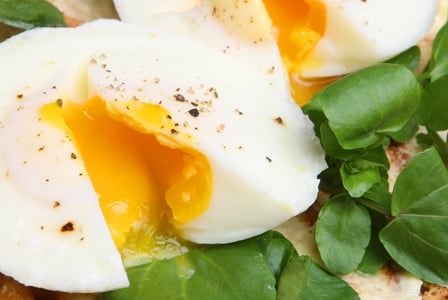
Poaching isnt just for the pros. Wow guests with delicately flavoured, low-calorie, nutrient-rich poached dishes.
Not that kind of poaching, silly. Poaching is one of those methods that can quickly be forgotten about, or brushed aside as something only the pros know how to do. No more!
It’s actually a fantastic way to keep foods moist and tender, while retaining nutrients that can be lost when boiling or charring. Although normally regarded as a means to cook delicate fish or eggs, lean meats and some vegetables can also be poached. It is also a fantastic way to avoid adding any sneaky calories from oils.
There are many different simple and scrummy ways to poach a whole host of things.
How it’s done
The basic method of poaching is to submerge food in liquid which has been heated to between 140 F (60 C) and 180 F (80 C), until bubbles have just begun to form on the base of the pan.
The type of liquid to use depends upon the dish that you are preparing; stock, water, or milk are good places to start. You will then need to add an acid such as lemon juice, wine, or vinegar, approximately 1/4 cup (60 mL) per 4 cups (1 L) of stock.
You can then flavour the liquid in pretty much any way you want to by adding herbs, spices, and vegetables. The best part is that no chopping is required, just throw them all in!
Bring the liquid to a boil, then add your meat, fish, or vegetables and reduce to a simmer. Make sure the liquid completely covers the meat or vegetables. As a rule of thumb, an 8 oz (225 g) piece of fish should take around 8 minutes, and an equal-sized portion of chicken should take 15 to 20 minutes.
Tips and tricks
Poached chicken works well in saucy dishes such as curry. Once the sauce is made and simmering away, add the chicken pieces and cook for around 20 minutes for juicy, tender chicken curry.
Poached eggs, while they can be tricky, are well worth perfecting. Most people have tried, and probably failed, with the vortex technique (whereby you swirl the simmering water and drop the egg into the centre). The problem here is that it’s only really good for one egg; any more and you end up with an eggy, soupy mess.
Don’t despair! Gentle is key here. Prepare a deep skillet with water, add about 1/4 cup (60 mL) white or malt vinegar, and bring to a gentle simmer. Crack the first egg into a cup. Place the edge of the cup onto the water before gently tipping the egg into the skillet. You can fold the edges of the white over the yolk with a slotted spoon if it has spread out too far. Repeat for each egg. Cook for 1 1/2 to 2 minutes until the white is cooked through but the yolk still moves to the touch. Gently place on a paper towel to drain before serving. Perfection on toast!

















